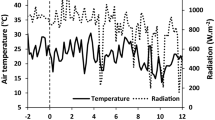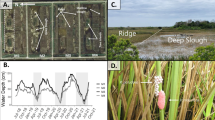Abstract
The United States hosts one native and five non-native species of aquatic apple snails (Ampullariidae). All are currently found in or around the Everglades in Florida. Two of these introduced species have devastated wetlands in Southeast Asia, but little is known about how they may impact the Everglades. To evaluate potential impacts of introduced apple snails relative to the native species, we investigated plant species preference, consumption rates, growth rates, and growth efficiencies in five introduced and the single native species across eight native macrophytes common in the Everglades. Three of the non-native snails are invasive, one has shown no tendency to expand, and one appears to have minimal direct impact on macrophytes due to its diet. All snails exhibited similar feeding preferences, with Utricularia sp. being the most preferred, Bacopa caroliniana, Sagittaria latifolia, and Nymphaea odorata being of intermediate preference, and Eleocharis cellulosa, Pontederia cordata, Panicum hemitomon and Typha sp. being least preferred (avoided as foods). Consumption and growth was minimal for P. diffusa on all macrophytes. On Utricularia sp. and Bacopa caroliniana, the invasive species Pomacea insularum and P. canaliculata tended to eat more, grow more, and have higher conversion efficiencies than the native P. paludosa or the non-invasive P. haustrum. These contrasts were more often significant for P. insularum than for P. canaliculata. The greater rates of expansion by the invasive species may derive from their enhanced feeding and growth rates.






Similar content being viewed by others
References
Aditya G, Raut SK (2001) Food of the snail, Pomacea bridgesi, introduced to India. Curr Sci 80:919–921
Baker P, Zimmanck F, Baker SM (2010) Feeding rates of an introduced freshwater gastropod Pomacea insularum on native and nonindigenous Aquatic plants in Florida. J Mollus Stud 76:138–143
Barnes MA, Fordham RK, Burks RL (2008) Fecundity of the exotic applesnail, Pomacea insularum. J North Am Benthol Soc 27(3):738–745
Bennetts RE, Collopy MW, Rogers JA Jr (1994) The snail kite in the Florida everglades: a food specialist in a changing environment. In: Davis SM, Ogden JC (eds) Everglades, the ecosystem and its restoration. St. Lucie Press, Delray Beach, pp 507–532
Boland BB, Meerhoff M, Fosalba C, Mazzeo N, Barnes MA, Burks RL (2008) Juvenile snails, adult appetities: contrasting resource consumption between two species of applesnails (Pomacea). J Mollus Stud 74:47–54
Burlakova LE, Karatayev AY, Padilla DK, Cartwright LD, Hollas DN (2009) Wetland restoration and invasive species: apple snail (Pomacea insularum) feeding on native and invasive aquatic plants. Restor Ecol 17:433–440
Burlakova LE, Padilla DK, Karatayev AY, Hollas DN, Cartwright LD, Nichol KD (2010) Differences in population dynamics and potential impacts of a freshwater invader driven by temporal habitat stability. Biol Invasions 12:927–941
Carlsson NO (2006) Invasive golden apple snails are threatening natural ecosystems in Southeast Asia. In: Joshi RC, Sebastian LS (eds) Global advances in ecology and management of golden apple snails. Phillipine Rice Research Institute, Munoz, Nueva Ecija, pp 61–72
Carlsson NOL, Brönmark C (2006) Size-dependent effects of an invasive herbivorous snail (Pomacea canaliculata) on macrophytes and periphyton in Asian wetlands. Freshw Biol 51:695–704
Carlsson NOL, Lacoursière JO (2005) Herbivory on aquatic vascular plants by the introduced golden apple snail (Pomacea canaliculata) in Lao, PDR. Biol Invasions 7:233–241
Carlsson NO, Brönmark C, Hansson L (2004) Invading herbivory: the golden apple snail alters ecosystem functioning in Asian Wetlands. Ecology 85:1575–1580
Conner SL, Pomeroy CM, Darby PC (2008) Density effects of native and exotic snails on growth in juvenile apple snails Pomacea paludosa: a laboratory experiment. J Mollus Stud 74:355–362
Conover WJ (1999) Practical non-parametric statistics, 3rd edn. Wiley, USA
Conover WJ, Iman RL (1981) Rank transformations as a bridge between parametric and nonparametric statistics. Am Stat 35:124–129
Cowie RH (2002) Apple snails (Ampullariidae) as agricultural pests: their biology, impacts, and management. In: Baker GM (ed) Molluscs as crop pests. CABI Publishing, NY, pp 145–192
Cowie RH, Hayes KA, Thiengo SC (2006) What are apple snails? Confused taxonomy and some preliminary resolution. In: Joshi RC, Sebastian LC (eds) Global advances in ecology and management of golden apple snails. Philippine Rice Research Institute, Muñoz, Nueva Ecija, pp 3–23
Darby PC, Valentine-Darby PL, Percival HF, Kitchens WM (2004) Florida apple snail (Pomacea paludosa) responses to lake habitat restoration activity. Arch Hydrobiol 161:561–575
Estebenet AL (1995) Food and feeding in Pomacea canaliculata. Veliger 38:277–283
Gettys LA, Haller WT, Mudge CR, Koschinick TJ (2008) Effect of temperature and feeding preference on submerged plants by the island apple snail, Pomacea insularum. Veliger 50:248–254
Greening HS, Gerritsen J (1987) Changes in macrophyte community structure following drought in the Okefenokee Swamp, Georgia, USA. Aquat Bot 28:113–128
Gunderson LH (1994) Vegetation of the everglades: determinants of community composition. In: Davis SM, Ogden JC (eds) Everglades, the ecosystem and its restoration. St. Lucie Press, Delray Beach, pp 323–340
Hayes KA, Joshi RC, Thiengo SC, Cowie RH (2008) Out of South America: multiple origins of non-native apple snails in Asia. Divers Distrib 14:701–712
Howells RG (2002) Comparative feeding of two species of apple snails (Pomacea). Ellipsaria 4:14–16
Joshi RC, Sebastian LS (2006) Global advances in ecology and management of golden apple snails. Phillipine Rice Research Institute, Munoz, Nueva Ecija
Lach L, Britton DK, Rundell RJ, Cowie RH (2000) Food preference and reproductive plasticity in an invasive freshwater snail. Biol Invasions 2:279–288
Lodge TE (2005) The everglades handbook: understanding the ecosystem, 2nd edn. CRC Press, Boca Raton
Lowe S, Browne M, Boudjelas S, De Poorter M (2000) 100 of the world’s worst invasive alien species. A selection from the global invasive species database. The invasive species specialist group. World conservation union. Hollands Printing Ltd, New Zealand
Mochida O (1991) Spread of freshwater Pomacea snails from Argentina to Asia. Micronesica Suppl 3:51–62
Morrison WE (2010) Aquatic plant-herbivore interactions across multiple spatial scales. Dissertation Georgia Institute of Technology, Georgia, p 115
Parker IM, Simberloff D, Lonsdale WM, Goodell K, Wonham M, Kareiva PM, Williamson MH, Von Holle B, Moyle PB, Byers JE, Goldwasser L (1999) Impact: toward a framework for understanding the ecological effects of invaders. Biol Invasions 1:3–19
Parker JD, Burkepile DE, Hay ME (2006) Opposing effects of native and exotic herbivores on plant invasions. Science 311:1459–1461
Pimentel D, Zuniga R, Morrison D (2005) Update on the environmental and economic costs associated with alien-invasive species in the United States. Ecol Econ 52:273–288
Rawlings TA, Hayes KA, Cowie RH, Collins TM (2007) The identity, distribution, and impacts of non-native apple snail s in the continental United States. Evol Biol 7:97
Roa R (1992) Design and analysis of multiple-choice feeding-preference experiments. Oecologia 89:509–515
Sala OE, Chapin FS III, Armesto JJ, Berlow E, Bloomfield J, Dirzo R, Huber-Sanwald E, Huenneke LF, Jackson RB, Kinzig A, Leemans R, Lodge DM, Mooney HA, Oesterheld M, Poff NL, Sykes MT, Walker BH, Walker M, Wall DH (2000) Global biodiversity scenarios for the year 2100. Science 287:1770–1774
Sharfstein B, Steinman AD (2001) Growth and survival of the Florida apple snail (Pomacea paludosa) fed 3 naturally occurring macrophyte assemblages. J North Am Benthol Soc 20:84–95
Sotka EE, Hay ME (2002) Geographic variation among herbivore populations in tolerance for a chemically-rich seaweed. Ecology 83:2721–2735
Stachowicz JJ, Hay ME (1996) Facultative mutualism between an herbivorous crab and a coralline alga: advantages of eating noxious seaweeds. Oecologia 105:377–387
Tamburi NE, Martin PR (2009) Feeding rates and food conversion efficiencies in the apple snail Pomacea canaliculata. Malacologia 51:221–232
Wilcove DS, Rothstein D, Dubow J, Phillips A, Losos E (1998) Quantifying threats to imperiled species in the United States: assessing the relative importance of habitat destruction, alien species, pollution, overexploitation and disease. Bioscience 48:607–615
Acknowledgments
Anya Brown, Zach Marion, and Krill Chernoff helped in the lab and field. Cynthia Guerra provided local expertise on South Florida. Chad Sexton helped with plant collections and provided P. insularum eggs from Georgia. Support provided via the National Science Foundation (Integrative Graduate Education and Research Traineeship Program) and the Harry and Linda Teasley endowment to Georgia Tech. Collection and transport of snails was conducted under Department of Agriculture permit number P526P-07-07248.
Author information
Authors and Affiliations
Corresponding author
Rights and permissions
About this article
Cite this article
Morrison, W.E., Hay, M.E. Feeding and growth of native, invasive and non-invasive alien apple snails (Ampullariidae) in the United States: Invasives eat more and grow more. Biol Invasions 13, 945–955 (2011). https://doi.org/10.1007/s10530-010-9881-x
Received:
Accepted:
Published:
Issue Date:
DOI: https://doi.org/10.1007/s10530-010-9881-x




